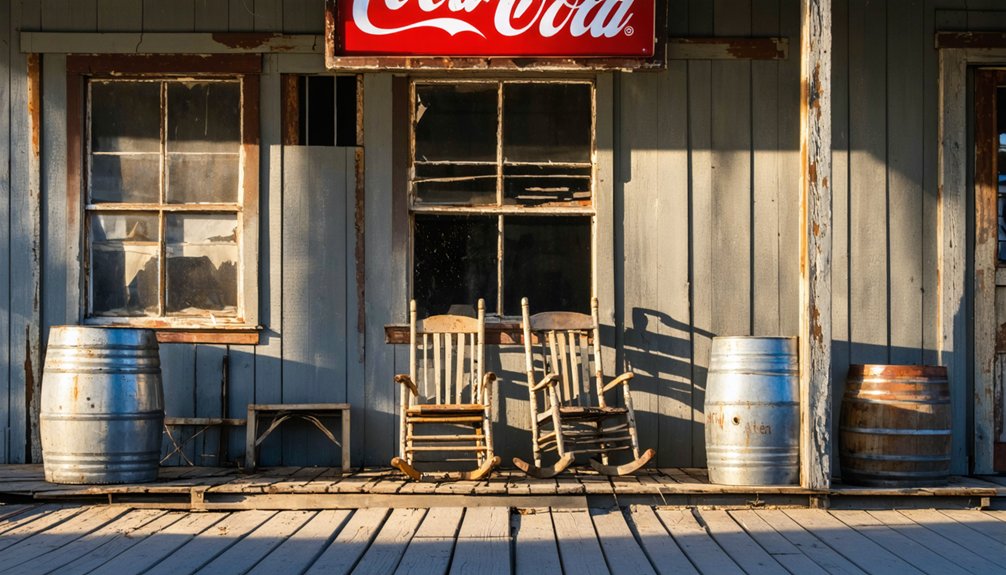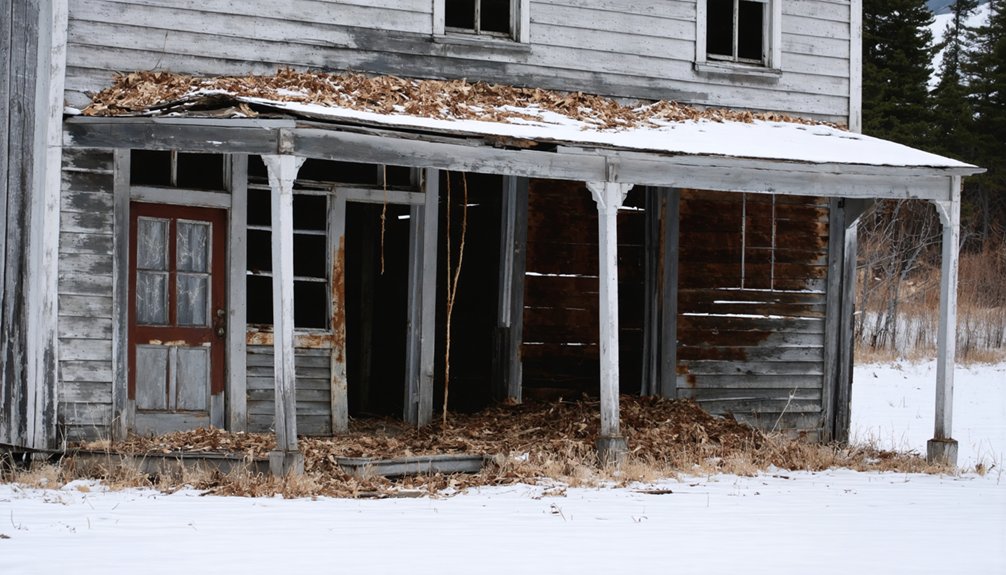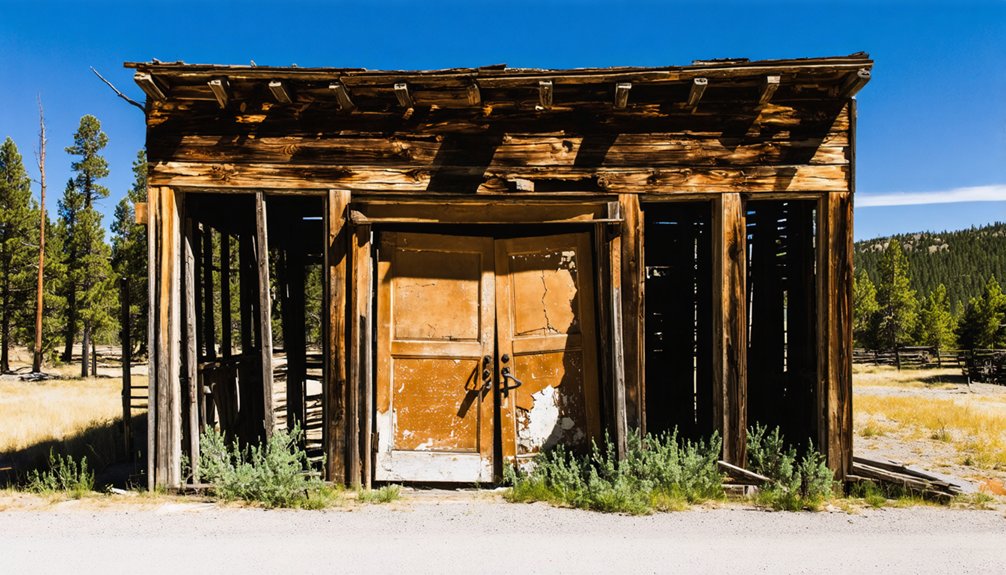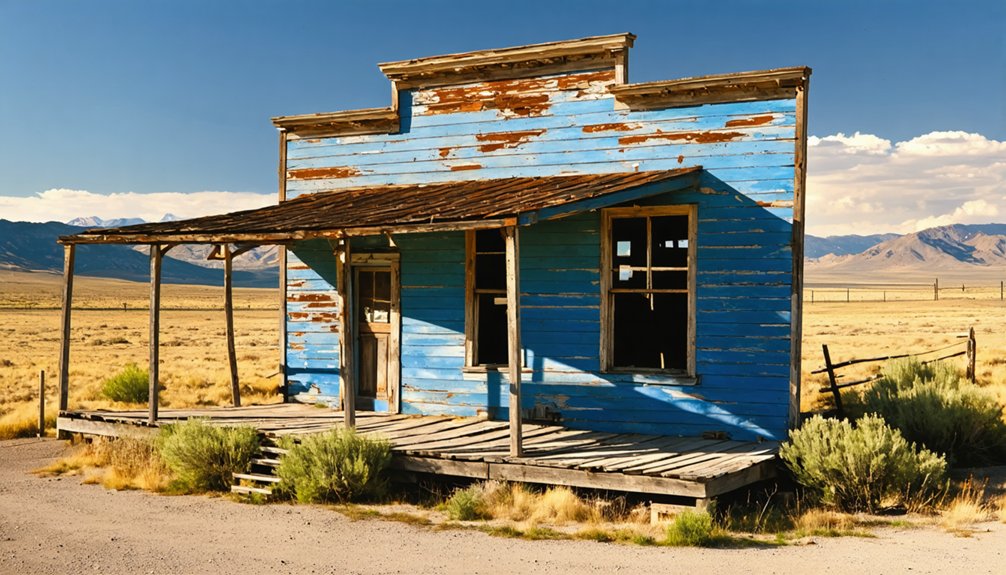You’ll find Soldier’s ghost town on Idaho’s Camas Prairie, where abandoned log structures mark a once-thriving agricultural settlement from the late 1800s. The town emerged after the Bannock War but declined when railroads bypassed it in 1911. At 5,000 feet elevation, settlers faced brutal winters and grasshopper invasions while building a resilient farming community. Today, weathered buildings and scattered artifacts reveal an authentic window into frontier life’s triumphs and challenges.
Key Takeaways
- Soldier, Idaho was an agricultural settlement established in the late 1800s that later declined when residents relocated to form Fairfield.
- The town’s decline accelerated in 1911 when railroads bypassed Soldier, causing economic migration and population loss.
- Original log structures remain at the townsite, though most are deteriorating and being reclaimed by native vegetation.
- The ghost town sits at 5,000 feet elevation in the Camas Prairie region, known for its historical grain farming and sheep ranching.
- The abandoned site offers an authentic view of early Idaho settlement life, with historic buildings and scattered artifacts still visible.
The Rise of a Prairie Settlement
As settlers ventured into the Camas Prairie region of Idaho in the late 1800s, the town of Soldier emerged as a promising agricultural settlement following the conclusion of the Bannock War.
You’ll find that the pioneer spirit drew ambitious farmers and ranchers who recognized the prairie’s fertile potential. They established roots in this strategic location, taking advantage of new irrigation methods to cultivate the land.
The settlement patterns followed the typical progression of western expansion, with Soldier’s position near the planned Oregon Short Line Railroad route attracting more pioneers. The area’s development mirrored nearby Mount Idaho, where pack trains and stages transported vital supplies to growing communities.
Despite harsh winters and initial challenges, the town’s early residents built a diverse economy. You could find thriving businesses, from feed stores to blacksmith shops, serving the growing population of farmers and ranchers who’d transformed the prairie into productive agricultural land. The town eventually evolved into Fairfield as residents relocated to establish a new community center.
Life on the Camas Prairie
You’d have found life on the Camas Prairie defined by its challenging high-altitude winters, where frosts and limited growing seasons tested early settlers’ resilience at 5,000 feet elevation.
The prairie’s agricultural heritage emerged through careful adaptation to these conditions, as families learned to sustain themselves through mixed farming and ranching economies near crucial water sources.
Despite harsh conditions, the shared struggles fostered tight-knit communities that worked together to overcome everything from grasshopper invasions to water scarcity, creating bonds that would shape the region’s character.
The native blue flowering camas plants that gave the prairie its name were once abundant here, providing essential food for indigenous peoples through their nutritious roots.
Harsh Winter Weather Challenges
While many frontier communities faced seasonal challenges, life on Idaho’s Camas Prairie demanded exceptional resilience against brutal winter conditions.
Current weather reports indicate sleet showers are pummeling the region at Soldier Mountain. You’d face temperatures plummeting to 20°F, with extreme fluctuations testing your winter survival skills. Blizzards would isolate your homestead for days, while snow management became a constant battle against 17.5 inches of annual snowfall and deep drifts. Recent weather data shows light mixed precipitation falling steadily, adding to the already challenging conditions.
- Wind-driven snow could bury your fences and roads within hours
- Ice storms threatened power lines and created treacherous travel conditions
- Temperature swings from 53°F to 28°F challenged both structures and livestock
- Snow accumulation delayed emergency services and cut off supply routes
- Freezing rain and flash ice formation made daily tasks hazardous
These harsh conditions eventually contributed to Soldier’s abandonment, as the relentless winters wore down even the hardiest settlers.
Agricultural Heritage Runs Deep
The rich soil of Idaho’s Camas Prairie held far more than just the promise of survival through harsh winters – it contained an agricultural legacy stretching back over eight millennia.
Native peoples, particularly the Nez Perce and Shoshone, demonstrated sustainable practices through their traditional harvesting of camas roots and other indigenous foods without depleting the land’s resources.
When European settlers arrived in the 1880s, they’d discover the prairie’s remarkable fertility, yielding grain harvests that outperformed established farming states threefold.
The cultural significance of agriculture deepened as Soldier town flourished with mills, blacksmiths, and commerce supporting local farmers.
You’ll find that by the early 1900s, the region had transformed into America’s premier sheep-ranching territory, while maintaining diverse crops from wheat to apples, adapting agricultural practices to the high desert’s unique conditions.
The region’s sheep production became increasingly profitable, leading to inevitable conflicts between cattlemen as they competed for grazing lands across the prairie.
Community Bonds Through Hardship
Beneath the rugged backdrop of Idaho’s Camas Prairie, close-knit communities like Soldier forged unshakeable bonds through shared adversity and mutual support.
You’ll find evidence of this community resilience in how settlers banded together during harsh winters, sharing resources and labor to guarantee everyone’s survival. Mollie Rowland exemplified this spirit by providing shelter to those in need.
- Settlers Day celebrations drew crowds of 200+, demonstrating peaceful social cohesion
- Local businesses formed interconnected networks providing essential services
- Railroad relocation prompted collective adaptation as residents moved to New Soldier
- Shared ranching and irrigation practices fostered cooperative relationships
- Religious institutions and public spaces strengthened community ties
These shared experiences created lasting connections that defined prairie life.
When you needed help, neighbors were there – whether it meant sharing tools, joining forces during harvest, or offering shelter in brutal weather.
Architecture and Notable Buildings
Located amid Idaho’s rugged terrain, Soldier’s architectural landscape exemplifies late 19th-century mining town construction, where practical wooden structures dominated the frontier skyline.
You’ll find locally sourced timber buildings that tell the story of rapid development during the mining boom, with full-length wooden boardwalks enhancing Main Street’s accessibility and appeal. The harsh winter conditions led to the development of snow removal teams that kept pathways clear between buildings. Like many boom-bust settlements of Idaho’s frontier, the town experienced rapid growth followed by eventual decline.
The town’s architectural significance shines through its notable structures, including Goff’s Hall, where you could catch a show for just 10 cents, and the Finch Hotel, which welcomed weary travelers.
While many buildings have succumbed to time, historical preservation efforts have maintained key structures that showcase the town’s mining heritage.
The remnants of smelters, charcoal kilns, and simple cabins stand as evidence to the industrious spirit that once thrived here.
Daily Life and Social Gatherings

During Soldier’s peak years around 1910, life pulsed through this Idaho mining town as residents forged tight-knit bonds through daily commerce and festive gatherings.
You’d find locals congregating at Cook’s Cash Store, Bashford’s Pioneer Store, and Mollie’s Café, where vibrant commerce mixed with friendly conversation. The annual Settlers Day celebration drew 200 people, showcasing the community’s pioneer spirit and peaceful nature. The town’s location in a 300-foot wide canyon created unique challenges for building placement and community gatherings.
- Merchants, barbers, blacksmiths, and other professionals formed the backbone of daily social interactions.
- The Mint Saloon served as a popular meeting spot for residents and travelers.
- Community events remained remarkably peaceful, with no reported arrests or disturbances.
- Local business leaders doubled as community influencers, shaping the town’s social fabric.
- A confectionery store with bulk candy barrels added sweetness to social occasions.
Farming and Ranching Legacy
While miners sought fortune underground, Soldier’s true lasting wealth lay in its fertile Camas Prairie soil.
You’ll find that as mining declined in the 1880s, settlers embraced the region’s agricultural potential, despite challenging high-altitude conditions and unpredictable weather patterns.
Farming innovations emerged through necessity, as settlers adapted to shorter growing seasons and developed irrigation systems to combat water scarcity.
Ranching practices flourished with extensive cattle and horse drives across the prairie, while the construction of a flour mill in 1900 marked the area’s commitment to grain production.
Though Soldier eventually faded into ghost town status, its agricultural legacy transformed the Camas Prairie landscape.
The shift from mining to farming and ranching created a sustainable community that thrived well into the early 20th century, shaping the region’s development and social fabric.
Weather Challenges and Adaptations

As harsh weather patterns swept across the Camas Prairie, Soldier’s residents faced extreme temperature swings that tested their resilience year-round.
You’d find settlers adapting to winter temperatures plummeting to 8°F and summer highs soaring into the mid-90s. These weather adaptations became essential for survival, as seasonal challenges demanded innovative solutions for both housing and daily activities.
- Wind-resistant building designs protected against gusts up to 13 mph
- Strategic placement of windbreaks shielded homesteads from bitter winter winds
- Water storage systems captured spring rainfall and snowmelt for summer use
- Layered clothing techniques helped combat wind chill during freezing months
- Careful monitoring of weather patterns guided farming and ranching decisions
Their resourcefulness in facing these weather extremes shaped Soldier’s character, though ultimately, nature’s fierce grip would contribute to the town’s eventual abandonment.
The Exodus Years
The arrival of railroads in neighboring towns marked the beginning of Soldier’s decline in 1911, following its peak population just a year before.
Soldier’s fortunes shifted as nearby railroad development lured residents away, initiating the town’s steady decline after 1911.
As economic migration took hold, families abandoned their homes, seeking better opportunities in railroad-connected communities like Boise and Mountain Home.
You’d have witnessed a gradual community decline as younger generations left, leaving behind aging residents. Local businesses couldn’t compete with better-connected towns, and without a railroad connection or major industry to sustain it, Soldier’s commercial activity withered.
The bank converted to a residence, while Goff’s Hall became storage space.
Though traditions like dances at Elk Creek continued, they drew fewer participants.
What Remains Today

If you venture into Soldier’s remote grounds today, you’ll find several original log structures still defiantly standing against time, though their weathered frames show clear signs of decay.
Nature has steadily reclaimed much of the townsite, with native vegetation pushing through building foundations and partial walls that outline where this once-bustling community stood.
While the site lacks formal preservation efforts or tourist amenities, its untouched state offers an authentic glimpse into Idaho’s mining past, with period artifacts scattered among the ruins and original creekbeds flowing just as they did in the town’s heyday.
Standing Historic Buildings
Standing amid the rugged Idaho landscape, Soldier’s remaining historic structures tell a compelling story of its mining past.
You’ll find timber-framed buildings and rough stone foundations that showcase the architectural significance of this frontier settlement. While historic preservation efforts remain limited, you can still explore the authentic remnants of mining operations and residential life.
- Original mine offices and processing buildings stand as proof of the town’s industrial heritage
- Weather-worn wooden homes reflect the simple yet sturdy construction methods of the era
- Isolated chimney stacks mark where frontier families once made their homes
- Mining-related structures retain vintage signage and operational markings
- Community building foundations reveal the layout of this once-bustling mining town
Lost to Prairie Land
Once bustling with miners and merchants, Soldier now sits quietly on Idaho’s Camas Prairie, where nature has steadily reclaimed its territory.
You’ll find hardy grasses and wildflowers pushing through the remnants of streets where townspeople once walked, while seasonal extremes continue their ancient rhythm across the landscape – deep winter snows giving way to scorching summers.
The town’s cultural significance lives on through scattered physical traces: old foundations peek through prairie grass, while fence lines and pathways hint at the community’s former layout.
You can still spot the converted bank building and Goff’s Hall standing defiant against time, though they’re now silent sentinels to memory preservation.
Beyond these surviving structures, the vast prairie stretches uninterrupted, returning the land to its original character.
Exploring the Ghost Town Responsibly
When exploring the historic ghost town of Soldier, Idaho, you’ll need to balance your curiosity with responsible preservation practices that protect both the site and its surroundings.
As a champion of sustainable tourism, your actions directly impact this heritage preservation site’s future. Remember that every footstep and artifact tells a story worth protecting.
- Pack essential safety gear including detailed maps, sturdy boots, and emergency supplies
- Stay on established paths to prevent erosion and protect archaeological remains
- Avoid entering restricted buildings like Goff’s Hall or the old bank
- Leave artifacts untouched and pack out all trash to maintain site integrity
- Keep noise levels low and respect fellow explorers while sharing viewing areas
These guidelines guarantee that future generations can experience Soldier’s remarkable history while preserving its authentic character.
Frequently Asked Questions
Was There a Train Station or Railroad Line Near Soldier?
You’ll find the Oregon Short Line Railroad ran about two miles south of Soldier, but the town didn’t get its own station, which proved significant in the train history’s impact on its decline.
What Native American Tribes Originally Inhabited the Soldier Area?
Along the windswept hills and river valleys, you’ll find the Northwestern Band of the Shoshone Nation were the primary inhabitants, establishing their cultural heritage through seasonal migrations and traditional settlements.
Were There Any Famous Outlaws or Notable Crimes in Soldier?
You won’t find records of famous outlaws or notable crimes specific to Soldier. While mining camps across Idaho faced widespread violence and criminal activity, Soldier’s history doesn’t highlight any distinctive outlaw incidents.
Did Soldier Have Its Own School System or Post Office?
Based on available Soldier history, you won’t find evidence of either a school system or post office. The Soldier community likely relied on nearby towns for these essential services.
What Was the Peak Population of Soldier During Its Most Prosperous Years?
Like a fleeting dream in Idaho’s mining history, you’ll find Soldier’s historic landmarks marked a peak population of 200 residents in 1910, when the Camas Prairie region flourished with frontier prosperity.
References
- https://www.youtube.com/watch?v=AQMyV46_T1I
- https://woodriverweekly.com/index.php/2020/07/15/soldier-booming-town-fades-into-history-fairfield/
- https://www.legendsofamerica.com/idaho-ghost-towns/
- https://www.familysearch.org/en/wiki/Soldier
- https://visitidaho.org/things-to-do/ghost-towns-mining-history/
- https://history.idaho.gov/wp-content/uploads/2018/08/0023.pdf
- https://yellowpinetimes.wordpress.com/2018/09/02/idaho-history-sept-2/
- https://sunvalleymag.com/articles/the-camas-prairie/
- https://elmorecounty.org/history/
- https://en.wikipedia.org/wiki/Camas_County



